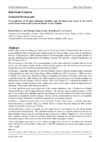Identificador persistente para citar o vincular este elemento:
https://accedacris.ulpgc.es/jspui/handle/10553/114080
| Título: | Geomorphology of the giant submarine landslides and salt diapirs that appear in the seabed around Fuerteventura and Lanzarote Islands (Canary Islands) | Autores/as: | Cuñarro Gómez, Manuel Mangas Viñuela, José Acosta, Juan Rivera, Jesús García, Levi |
Clasificación UNESCO: | 250607 Geomorfología 251090 Geología marina |
Fecha de publicación: | 2014 | Conferencia: | IV Congress of Marine Sciences | Resumen: | In this study we are describing the seabed around the Canary Islands of Fuerteventura and Lanzarote, using multibeam echosounder data taken mainly during four oceanographic surveys made by the Spanish Institute of Oceanography (IEO, Instituto Espan˜ol de Oceanografía) and the Hydrographic Institute of the Navy (IHM, Instituto Hidrográfico de la Marina) between 1998 and 2011, using R/V Hespérides and R/V Vizconde de Eza. We are focusing on the study of the geomorphology of the giant submarine landslides that are found on the west side of these islands and the (salt) diapirs that appear in the J.M. Fuster Casas sedimentary trough (between Africa and Fuerteventura-Lanzarote Islands). On one hand, submarine landslides are relatively frequent events in volcanic oceanic islands associated with mantle plumes such as the Canary Islands (Watts and Masson, 1995; Masson et al., 2002; Acosta et al., 2003a, etc.), Cape Verde, Reunion and Hawaii, being Hawaii Islands the first place where they were studied (Lipman et al., 1988; Moore et al., 1989). Landslides play an important role in the evolution and destruction of oceanic intraplate volcanic islands. They start as subaerial or submarine instabilities that displace a huge amount of igneous rocks, sedimentary rocks and sediments, which are deposited in the submarine island slopes and/or the abyssal plains. Two main landslides have been recognized in the western submarine slope of Fuerteventura Island: ‘Puerto del Rosario’ and ‘Southern Puerto del Rosario’. The first one, with an estimated surface of 3700 km2, is one of the largest landslides that has been found in the Canary Islands and has kilometric blocks in diameter and hundreds of meters in height. We also delimit several kilometric channels with hundreds of meters of slope. Paleodebris avalanches generate these sedimentary deposits. In addition, a slump is located to the west of Lanzarote. In this surface, up to 11 volcanic cones have been measured and identified. They are probably related to recent volcanism during the 18th and 19th century in Lanzarote (Acosta et al., 2003a). On the other hand, at least 13 mounds and salt diapir mounds were found in the east off the islands of Fuerteventura and Lanzarote. The salt diapir mounds are related to evaporite deposits formed in the Proto-Atlantic Ocean during the Late Triassic age (Acosta et al., 2003b; Uchupi et al., 1976). Some of these evaporitic deposits reached the seabed by plastic flow, forming the salt domes observed in swath bathymetry images. These salt intrusions affect to the entire stratigraphic column. The studied diapirs range from 57 to 357 meters in height, from 5 to 63 km2 in surface area and from 0.15 to 16 km3 in volume (Table 1). They show a NE-SW orientation and are located within a range of 1200 m depth. | URI: | https://accedacris.ulpgc.es/handle/10553/114080 | ISBN: | 84-697-0471-0 | Fuente: | Book of Abstracts submitted to the IV Congress of Marine Sciences. Las Palmas de Gran Canaria, June 11th to 13th 2014, p.p. 193-194 |
| Colección: | Actas de congresos |
Visitas
67
actualizado el 18-may-2024
Descargas
24
actualizado el 18-may-2024
Google ScholarTM
Verifica
Altmetric
Comparte
Exporta metadatos
Los elementos en ULPGC accedaCRIS están protegidos por derechos de autor con todos los derechos reservados, a menos que se indique lo contrario.
